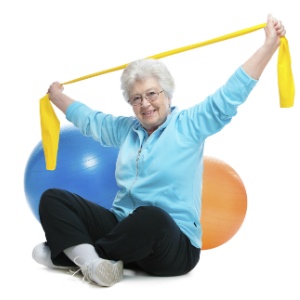Studies indicate an overwhelming percentage of older adults in the United States prefer to age at home, and one of the best ways to remain independent is to stay physically active.
There is nothing startling in that statement, but new research shows even bigger benefits to exercise for older adults than anticipated. We’d like to share highlights of that research, and then suggest four physical activities for older adults that will keep them healthy — and out of the nursing home.
Overview of New Research
Research conducted by the Norwegian University of Science and Technology tested more than 5,000 older adults in a mobile exercise lab and developed an online fitness calculator that would show the fitness age of a person.
Someone who quickly became enthusiastic about this calculator is competitive triathlete Dr. Pamela Peeke, an assistant professor of medicine at the University of Maryland. Peeke is 61 years old chronologically, but her fitness age is an incredible 36. To gather additional data about the importance of exercise for older adults, she encouraged participants of the National Senior Games — known informally as the Senior Olympics — to test themselves on the calculator; more than 4,200 of them did.
Astonishing Results
Although the average chronological age of these athletes was 68, the average fitness age was 43 — an astonishing 25 years younger. Men and women alike showed these results and, even more encouraging, these statistics weren’t simply skewed by a percentage of super-fit individuals. Nearly every single older athlete tested younger than his or her chronological age. And, many of these athletes began exercising regularly in their middle-aged years — or even later — suggesting that it’s seldom too late to benefit from exercise.
4 Types of Exercise to Try
If you’re returning to exercise, it’s important to discuss a strategy with your doctor. Overall, the National Institute on Aging (NIA) recommends older adults participate in the four main types of exercise.
- Aerobic exercises that increase your breathing and heart rate
- Strength exercises
- Balance exercises
- Flexibility/stretching exercises
The Centers for Disease Control and Prevention (CDC) recommends older adults pick activities they enjoy and match their abilities. This helps them stick with a fitness program. Incorporating other activities keeps older adults from getting bored.
Excellent Resource: Go 4 Life
To take a look at specific exercise options, go to the Go 4 Life website by the NIA. You can look at the four types of exercise and find a wide range of options you can tailor to your abilities:
- Endurance exercises
- Sports: tennis, golf, pickleball, hockey, seated volleyball, wheelchair basketball
- Indoor activities: fitness center (treadmill, elliptical machine, stationary bike, rowing machine), swimming laps, water aerobics, dancing, martial arts, bowling
- Outdoor activities: biking, horseback riding, sailing, jogging/running, skating, snorkeling
- Around the house: gardening, DVD exercise routines, raking, shoveling snow, sweeping
- Walking or rolling: hiking, walking the dog, mall walking, wheelchair rolling, race walking
- Strength exercises: See this page for exercises specifically targeted for the upper body and the lower body using weights and resistance bands.
- Balance exercises: These include tai chi and specific body movements that improve balance.
- Flexibility exercises: See specific examples for different parts of your body.
Also scroll down on each of these pages to find tips that help exercise safely.
Whether you’re just beginning an exercise regimen or have an established routine, remaining physically active is an important step in maintaining your independence. For more tips, download our free guide.













